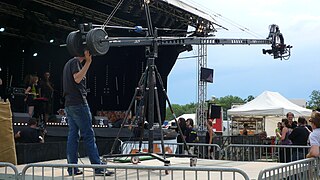Grip (film job)
Grip is the name of a film technology profession . The grip works as part of the film staff in the camera department , or, as it is colloquially known, in the picture. The Key Grip is the boss of the grip crew; the operator of the camera dolly is Dolly Grip called; the grip assistant is subordinate to both of them .
In Germany and Austria, the job title is camera stage, sometimes also revolving stage or simply stage . The head of the camera Stage Crew is first dolly grip called . In German-speaking Switzerland, the Grip is referred to as a machinist or, in a managerial position, as a chief machinist . The term was taken from French Switzerland or France, where the function is machiniste or chef machiniste .
tasks
The Grip or dolly grip man or dolly grip woman is responsible on set for secure fastening and moving the camera.
This area of responsibility includes:
- Construction and backup of all camera systems.
- Safe positioning of the camera tripod , be it in the studio or on rough terrain.
- The leveling of rails for the camera car ( dolly ) and the movement of the dolly during the recordings in consultation with the camera and direction.
- Construction and operation of camera cranes . In Germany, a valid certificate of competence is required for this.
- All types of riggings (fixings, stage structures) on the film set . This includes simple substructures for cameras or actors as well as the mounting of camera-bearing systems on platforms, lifting platforms, towers, in windows, on roofs and on vehicles of all kinds.
- In the USA and Canada, Grip is also responsible for the construction of light-carrying systems for headlights and the associated non-electrified equipment such as diffusers, reflectors and flags.
The Grip works closely with the cameraman , camera assistant and lighting technician , but is ultimately, like them, under the direction .
Camera movements
In addition to safety aspects, the Grip is characterized by the ability to move cameras using dolly or crane as smoothly and smoothly as possible.
Dolly trips are also called traveling . A distinction is made between track-in and track-out journeys (into the picture - also called condensing - or out of the picture), lateral journeys (across the image) and circular journeys . When it comes to cranes, one also speaks of strokes and swings .
The grip is ideally also involved in the considerations that lead to tracking shots . There are different views among camera operators and directors about the motivation of movements. Quite a few believe that a camera movement always needs a reason, for example the movement of an actor or the condensation on a face as a dramatic accent. Others believe that camera movements are possible at any time, as long as they bring a formal or aesthetic gain. This discussion is mainly limited to the narrative film (feature film, series). In commercials and music videos , aesthetic gain is a sufficient reason for camera movement.
conditions
- Manual and technical skill and corresponding knowledge.
- Knowledge of the visual and dramaturgical effect of camera settings, camera movements and their implementation.
- Knowledge of dollies, camera cranes, all camera-bearing systems and aids. Certificate of proficiency for setting up and operating cranes.
- General knowledge of cameras, focal lengths and image formats.
- Practical basic knowledge of mechanics, statics and dynamics.
- Teamwork.
- The ability to always ensure safety on set, even under pressure and after long working days.
As a profession, grip can only be learned in practice.
gallery
Individual evidence
- ↑ Camera stage. Retrieved April 20, 2018 (German).
- ↑ First dolly grip - Movieki. Retrieved April 20, 2018 .
- ↑ SSFV: job descriptions. Retrieved January 20, 2020 .
- ↑ Lighting / Stage eV: Job profiles of the filmmaking professions, p. 13. (No longer available online.) Federal Association of Filmmakers' Associations, April 1st, 2014, archived from the original on June 4th, 2016 ; accessed on January 21, 2020 . Info: The archive link was inserted automatically and has not yet been checked. Please check the original and archive link according to the instructions and then remove this notice.
- ↑ SSFV: job descriptions. Retrieved January 20, 2020 .
- ^ Administrative trade association VBG: camera cranes. Verwaltungs-Berufsgenossenschaft VBG, March 1, 2004, accessed on April 20, 2018 .
- ^ The filmmakers. Federal Association of Filmmakers' Associations, accessed on January 21, 2020 .
- ↑ SSFV: job descriptions. Retrieved January 20, 2020 .




